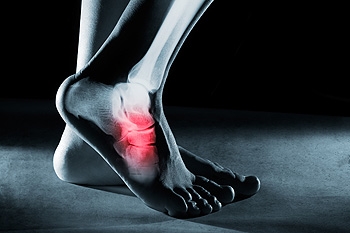
 If you have pain on the outside of your foot, you may have cuboid syndrome. The cuboid is a bone on the outer part of your foot. The ailment occurs when this bone moves out of its place. There is no concrete test for cuboid syndrome, so many times, the pain is misdiagnosed. If you have sprained your ankle before, engage in activities such as ballet or running, or have flat feet, you may be more likely to incur this condition. Luckily, this infliction is typically simple to treat. For example, you can perform exercises in order to strengthen the foot. Additionally, a doctor may be able to manipulate the foot to put the cuboid bone back in its proper location. Medical tape, orthotics, and a “cuboid wedge” could also be used to fix the placement of the bone. For relief from the discomfort, you can apply ice to your foot and rest as much as possible. If you believe you may have this condition, it is suggested that you consult with a podiatrist.
If you have pain on the outside of your foot, you may have cuboid syndrome. The cuboid is a bone on the outer part of your foot. The ailment occurs when this bone moves out of its place. There is no concrete test for cuboid syndrome, so many times, the pain is misdiagnosed. If you have sprained your ankle before, engage in activities such as ballet or running, or have flat feet, you may be more likely to incur this condition. Luckily, this infliction is typically simple to treat. For example, you can perform exercises in order to strengthen the foot. Additionally, a doctor may be able to manipulate the foot to put the cuboid bone back in its proper location. Medical tape, orthotics, and a “cuboid wedge” could also be used to fix the placement of the bone. For relief from the discomfort, you can apply ice to your foot and rest as much as possible. If you believe you may have this condition, it is suggested that you consult with a podiatrist.
Cuboid syndrome, also known as cuboid subluxation, occurs when the joints and ligaments near the cuboid bone in the foot become torn. If you have cuboid syndrome, consult with Dr.Eji Shobowale from DeNiel Foot & Ankle Center. Our doctor will assess your condition and provide you with quality foot and ankle treatment.
Cuboid syndrome is a common cause of lateral foot pain, which is pain on the outside of the foot. The condition may happen suddenly due to an ankle sprain, or it may develop slowly overtime from repetitive tension through the bone and surrounding structures.
Causes
The most common causes of cuboid syndrome include:
- Injury – The most common cause of this ailment is an ankle sprain.
- Repetitive Strain – Tension placed through the peroneus longus muscle from repetitive activities such as jumping and running may cause excessive traction on the bone causing it to sublux.
- Altered Foot Biomechanics – Most people suffering from cuboid subluxation have flat feet.
Symptoms
A common symptom of cuboid syndrome is pain along the outside of the foot which can be felt in the ankle and toes. This pain may create walking difficulties and may cause those with the condition to walk with a limp.
Diagnosis
Diagnosis of cuboid syndrome is often difficult, and it is often misdiagnosed. X-rays, MRIs and CT scans often fail to properly show the cuboid subluxation. Although there isn’t a specific test used to diagnose cuboid syndrome, your podiatrist will usually check if pain is felt while pressing firmly on the cuboid bone of your foot.
Treatment
Just as the range of causes varies widely, so do treatments. Some more common treatments are ice therapy, rest, exercise, taping, and orthotics.
If you have any questions, please feel free to contact our office located in Cypress, TX. We offer the newest diagnostic and treatment technologies for all your foot care needs.
Read more about Cuboid Syndrome
Related Posts
No related posts.

